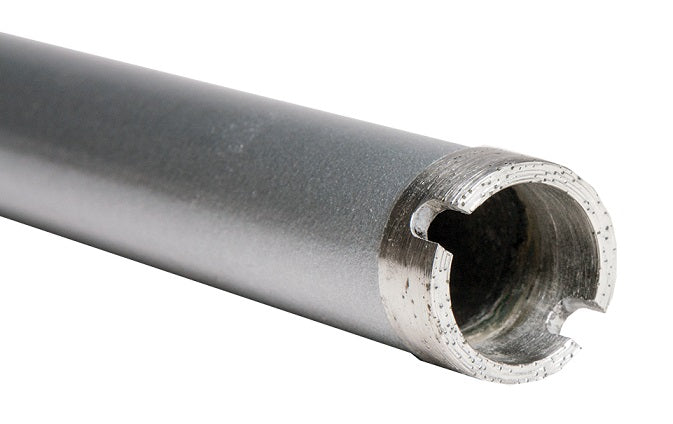cavemanmike
Well-known member
Pm sent
Rob - thanks; agreed. But the site in question is only 3 or 4 metres into the sump, so the battery could easily be left on land. Sam - thanks; yes, I'm sure you're right. But if the above was the situation, it'd only be the drill electronics we'd need to worry about. Worst case scenario is that it kills the drill (it's not going to cause a major fire in a sump). Maybe possible with a very old / sacrificial drill - or even a dirt cheap new one from Lidl / Aldi?
Here's a picture of the site. There is a thin airspace overhead (i.e. it's extremely shallow). What looks like the roof is merely a reflection; the real roof is very dark and is only about 20 mm above the water surface. You can see that the smaller slab to the right has suffered some abuse. We managed to jack the two apart to where they are now before both jammed. What we want to do is drill a line of 14 mm holes in the larger left hand slab, then use plugs & feathers to split it. Even chamfering just 100 mm off it would greatly help. We've been passing over this for a year with never more than 2 x 7 litre tanks on. I suspect that soon we'll need to get a lot bigger tanks through this restriction.
Does anyone have an old model of an SDS drill they never use (due to batteries knackered or superseded by a far newer / more efficient model) who might be willing to donate it to the cause? Maybe an old Bosch 24VRE, which has fairly unsophisticated electrics? I gave two away myself recently, as they were redundant (fool that I am!)
Thanks for the suggestion.Use an air drill. Skipton Hire Centre have some. Or, try Settle Coal.
Thanks - that's exactly what I was thinking; battery on the surface and a short cable feeding the actual drill.
Thats an interesting idea . . . . will give it some thought.Have you tried putting the drill in a sealed plastic bag with an air supply pump in from the surface
I am looking into this option for Rickford.Would a hydraulic core drill be an option? Obviously you’d need to be able to get a hydraulic power pack to the entrance! Might be easier to get hold of than an underwater cordless drill though…
My experience of hydraulic coring and borehole drilling equipment is that you get significant power losses through additional lengths of hydraulic hose as compared to compressed air. I've not used a a hydraulic hammer drill but you may need to be closer than you think to the power pack to maintain drill speed for the hammer action to work properly.I am looking into this option for Rickford.
You can pick up a 2nd hand hydraulic power pack for a few hundred pounds (that may or may not work!) or you can hire one that will definitely work for £100/week from Speedy.
The tricky bit is the underwater drill, which is about £3k to buy from here, or can be hired from an offshore firm in Aberdeen. If anyone else is interested in this as an option, let me know, as I'm talking to the suppliers already to see what might work.
My experience of hydraulic coring and borehole drilling equipment is that you get significant power losses through additional lengths of hydraulic hose as compared to compressed air. I've not used a a hydraulic hammer drill but you may need to be closer than you think to the power pack to maintain drill speed for the hammer action to work properly.


 www.powertoolsalesuk.com
www.powertoolsalesuk.com
I don’t think that would be anywhere near powerful enough to spin a core bit unfortunately. Core drills have pretty powerful motors for high revs/high torque.What about a 14mm core bit (no hammer action required)

Wet Diamond Core Drill Bit 14mm x 350 x 1/2in BSP (M) - DURO
The 14DPWC (Crown) is a professional wet diamond drill bit for high speed drilling with long life. Ideal for reinforced and non-reinforced concrete plus hard brick and blocks. Features: Crown Height: 8mm Bit Diameter: 14mm Bit Length: 350mm Dry/ Wet: Wet Ventilation: Requires Water Cooling Core...rapidtoolsdirect.co.uk
and something like this (air consumption 3.25 litres p/s)

8941097910 CP9791C Chicago Pneumatic 1/2" Pistol Grip Air Drill
CP9791C Chicago Pneumatic 1/2" Pistol Grip Air Drill - Industrial quality Jacob's keyless Chuck, Reversible, 800 rpmwww.powertoolsalesuk.com
Run off a 15ltr tank at 210bar = 3150 litres
gives you 16mins drilling time
All the above subject to available chuck sizes and me not really knowing what I am talking about
